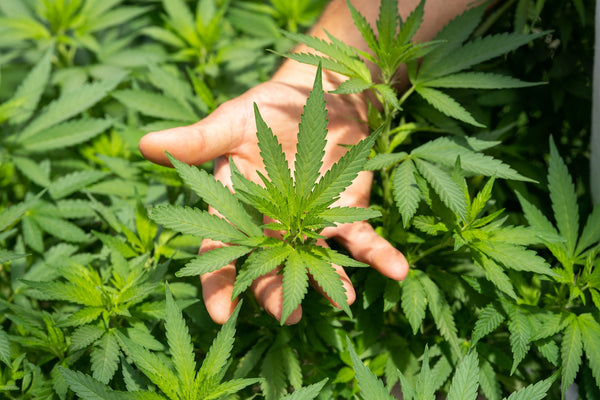Anyone who’s used or been around cannabis knows its iconic scent. But why does the cannabis plant have such a distinct smell?
It comes from terpenes — fragrant oils that give all plants (and some insects) their characteristic aromatic signature.
Aromatherapy is nothing new: People have used various scents to evoke different feelings for many applications. And it all comes down to terpenes.
What Are Cannabis-Derived Terpenes?
Every variety of cannabis has a unique combination of terpenes responsible for its different therapeutic effects; the terpenes make the strain.
However, plants produce terpenes for more than accent; they provide evolutionary advantages. For example, different terpenes can lure pollinators, offer protection from predators, deter diseases and insects, etc.
The cannabis plant’s trichomes (resin glands) in its buds (flowers) secrete terpenes, the same part of the plant that produces cannabinoids like CBD and THC. And those cannabinoids don’t have a scent; again, it’s all in the terpenes.
Cannabis flowers typically have a terpene concentration of between one and ten percent. However, selective breeding can create cannabis plants with a higher terpene count.
Related: CBD: Broad-Spectrum vs. Full-Spectrum

What Is the Most Common Terpene In Cannabis?
Myrcene is the most common terpene in most cannabis plants, making up as much as two-thirds of the terpene profile. More on this later.
Do Cannabis-Derived Terpenes Get You High?
No, cannabis-derived terpenes will not get you high. However, some are considered psychoactive and affect the brain.
And while terpenes aren’t psychotropic like THC, they can impact its effects, making certain ones stronger or weaker.
Cannabis-Derived Terpenes vs. Botanical Terpenes
Botanically-derived terpenes are usually non-toxic; many FDA-approved food additives contain them. However, adding botanical terpenes to cannabis plants that aren’t naturally found in them is a “no-no.”
Why? Because we don’t know what will happen. It’s possible that adding non-native terpenes to cannabis plants could metabolize to other chemicals, having distinct pharmacological effects.
On the other hand, cannabis-derived terpenes only come from the cannabis plant — nature gives it specific terpenes for a good reason. Attempting to recreate cannabis-derived terpenes’ unique odor and flavor profiles has not gone well.
In addition, many cannabis connoisseurs dislike when growers introduce outside terpenes to achieve a specific profile — one reason why the High Times Cannabis Cup only allows the entry of plants with 100% cannabis-derived terpenes.
Finally, cannabis-derived terpenes are ideal to preserve the biochemical and psychological properties of the cannabis plant.
What About Synthetic Terpenes?
Other than botanical-derived terpenes and cannabis-derived terpenes, we have synthetic terpenes: Ones that aren’t found anywhere in nature.
While synthetic terpenes aim to mimic the aromatic profile of cannabis, most are derived from various petroleum products that are unsafe for human consumption. In addition, many contain toxic components.
The CO2 extraction process destroys many terpenes, so some companies use synthetics to cut costs and restore the plant’s original aromatic signature.
Related: CBD for Concentration

What Are the Benefits of Cannabis-Derived Terpenes? A Guide To 15 Popular Terpenes in Cannabis
Cannabis-derived terpenes offer various benefits, from pain relief to anxiety management. These terpenes can:
- Enhance norepinephrine activity
- Act as serotonin uptake inhibitors
- Increase dopamine
- Act on various receptors and neurotransmitters
- Augment GABA
But what do these terpenes actually do?
Myrcene: We mentioned earlier that this terpene is the most common in cannabis plants. It has an aroma similar to cloves. Myrcene is known for its sedative effects, making it popular for pain relief, sleep, and reducing inflammation.
Linalool: This cannabis-derived terpene has a spicy, floral note that’s also present in mint and lavender. Like those herbs, it has relaxing properties and helps reduce anxiety.
Pinene: Alpha-pinene and beta-pinene have a pine-like aroma that has anti-inflammatory benefits and bronchodilator properties, making them effective for treating conditions like asthma.
Eucalyptol: Also called cineole, this terpene also appears in the eucalyptus tree and has a refreshing minty smell. Eucalyptol can help relieve pain, slow bacteria growth, promote relaxation, and enhance cognitive functions.
Humulene: Commonly found in hops, black pepper, and cannabis, humulene is an earthy, woody terpene with various benefits. For example, it can prevent cancer cells from growing, suppress appetite, and reduce inflammation.
Camphene: With a sweet, earthy aroma, this cannabis-derived terpene is similar to myrcene. It’s synthesized from pinene, giving it many of the same benefits. In addition, it can lower triglycerides and cholesterol levels.
Terpineol: Similar to mint and anise, terpineol has a sweet floral scent, providing a relaxing and calming experience. It may also help treat depression and anxiety.
Geraniol: This rare terpene is often found in cannabis strains high in CBD; it also exists in roses, tobacco, and various fruits. While typically used in aromatic products like lotions, it also shows potential to improve cognitive function.
Limonene: This secondary termine, found in many cannabis strains, has a citrusy smell and taste. Its benefits include reducing stress and acting as an antioxidant and anti-inflammatory.
Caryophyllene: This spicy, peppery terpene is abundant in cannabis strains with high THC content. It’s a key ingredient for anti-inflammatories and may also help treat alcoholism and withdrawal symptoms.
Alpha-bisabolol: Another flowery terpene, bisabolol, is found in cannabis and chamomile flowers. While popular in the cosmetics industry, some research shows that it may be packed with medicinal benefits.
Trans-nerolidol: Found in jasmine and tea tree oil, many industries use this secondary terpene for its widespread occurrence and wonderful aroma. Trans-nerolidol also has antioxidant properties, among other health benefits.
Delta-3-carene: This terpene is known for its sweet, earthy aroma with hints of citrus that leave you with a refreshing cooling sensation. However, it also may support bone growth and enhance cognitive function.
Borneol: These terpenes contain minty, herbal scents and flavors and are a part of many popular cannabis strains. Not only does it work as an insect repellent, it may also destroy breast cancer cells.
Valencene: Last but not least, the valencene terpene has a sweet, citrusy aroma that can instantly lift your mood. It’s rich in citrus, has anti-inflammatory properties, and may help with cancer treatments, melanoma, and dermatitis.
Wow, that’s a lot of info. Want to find your perfect CBD match in minutes? Click here.
Related: Is CBD an Antioxidant?
